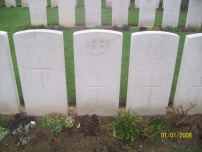| First Name: | Charles William | Last Name: | PALMER | |
|---|---|---|---|---|
| Date of Death: | 23/04/1917 | Lived/Born In: | Gunnersbury | |
| Rank: | Private | Unit: | Middlesex1 | |
| Memorial Site: | Brentford Memorial | |||
Current Information:Enlisted-Chiswick Heninel-Croisilles Road Cemetery, France
The Battle of Arras was a series of offensives by the British Army between 9th April 1917 and 16th May 1917. It had been planned in conjunction with the French who would attack in Artois and between them the Allies would force the Germans out of the large salient they had held since the line of trenches was first established. But the Germans had spoiled this plan by falling back to the new and very strong Hindenburg Line in January 1917 and the salient no longer existed. For the want of an alternative plan the attack went ahead anyway. It all started well for the British who made substantial gains on the first two days but then the offensive ground to a halt and by the end their losses amounted to over 150,000. The Second Battle of the Scarpe (23-24 April, 1917) The British offensive at Arras was resumed on 23rd April, 1917, when they attacked eastwards along an nine mile front from Croisilles to Gavrelle on both sides of the River Scarpe in what some came to consider was the hardest fighting of the war so far. On the right of the British line, 33rd Division attacked the Hindenburg Line astride the Sensée, more of a stream than a river. The main attack was made at 4.45am by 98 Brigade north of the stream when the 4th Suffolk battalion on the right bombed their way down the Hindenburg trenches to the Sensée while on the left, the 2nd Argylle & Sutherland Highlanders and 1st Middlesex battalions advanced across the spur to the north. 4th Suffolk plus two companies of 2nd Royal Welsh Fusiliers from 19 Brigade in support, ably assisted by a tank, advanced along both trenches for 200 yards to the Chérisy-Croiselles road where they were brought to a halt. The inner flanks of 2nd Argylle & Sutherland Highlanders and 1st Middlesex were held up by machine-gun fire from a copse on the crest of the spur which the artillery barrage had overlooked. Around mid morning the enemy counter attacked from the north-east, cutting off the forward companies and at 2pm. the leading companies of 4th Suffolk made their way back from their isolated position by taking advantage of the folds in the land. However, those of 2nd Argylle & Sutherland Highlanders and 1st Middlesex remained in their isolated and cut off positions. A renewed attack by the supporting companies was ordered for 6pm but, advancing across the open in broad daylight with an ineffective barrage they had even less chance and at 7.45pm, 2nd Royal Welsh Fusiliers had to fight off a strong counter attack on the barrier in the support trench. The following morning, patrols discovered that the enemy had retired down the hill to the Chérisy-Croisilles road and the general advance was able to continue. They moved along the Hindenburg Line to where the Fontaine-St Martin road was crossed and there the isolated companies of 2nd Argylle & Sutherland Highlanders and 1st Middlesex were reached. They had been hanging on in the face of heavy pressure and had even managed to take some of the enemy prisoners. They were relieved that night and on 25th April 1st Middlesex moved back to Grosville. One of the many casualties suffered by 98 Brigade during this operation was Charles Palmer of 1st Middlesex who was killed on 23rd April. |
||||
Other Photos: |
||||
| « Back to Search Results | ||||
| If you think any of the information shown here is incorrect, Click Here to submit your amends and comments | ||||





